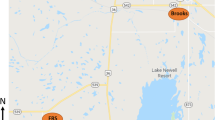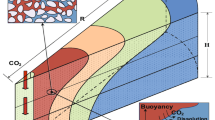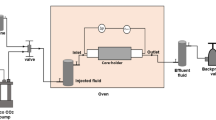Abstract
In subsurface storage of CO2 in saline aquifer, dissolution trapping is presumed to be the most feasible trapping mechanism that ensures storage safety by initial immobilization of injected buoyant CO2. Time span for this natural mechanism is, however, spanning in terms of decades. Accelerating the rate of dissolution by imposing various reservoir engineering principles is the peer area of research interest. Though dissolution of CO2 depends on pressure of the system, pressure buildup during injection process could potentially create or activate fractures, providing migration pathways for buoyant CO2 that questions safety of storage. Attempt has been made in the present paper to understand the impact of various injection scenarios, such as water alternate gas (WAG), intermittent and intermittent WAG injection scenario, toward enhancing dissolution rate with associated minimal effect on pressure buildup. Numerical model conceptualizing immiscible two-phase flow has been developed. Effect of hysteresis of relative permeability has been considered, and solubility of CO2 in brine is computed using developed thermodynamic model. An enhanced dissolution rate of about 68 % has been observed in case of WAG scenario, however with associated disadvantage on drastic borehole pressure buildup. On the contrary, lesser borehole pressure buildup has been observed in intermittent injection case, while dissolution rate is significantly lesser when compared with WAG process. Interestingly, it has also been inferred from present study that intermittent WAG process plays a crucial role in eliminating the primary disadvantages of WAG and intermittent process with promising enhanced dissolution rate than WAG and intermittent processes.








Similar content being viewed by others
Abbreviations
- ϕ :
-
Porosity (fraction)
- K :
-
Intrinsic permeability (m2)
- k rα :
-
Relative permeability of α phase (fraction)
- P α :
-
Pressure of α phase (Pa)
- S α :
-
Saturation of α phase (fraction)
- S rα :
-
Irreducible saturation of α phase (fraction)
- μ α :
-
Viscosity of α phase (Pa s)
- ρ α :
-
Density of α phase (kg/m3)
- q α :
-
Darcy flux (m/s)
- Q α :
-
Source term (kg/m3s)
- C g :
-
Compressibility of CO2 (Pa−1)
- P c :
-
Capillary pressure (Pa)
- P o :
-
Entry pressure (Pa)
- m :
-
Pore size distribution index
- n :
-
Number of moles (mol)
- v α,inj :
-
Injection rate (m/s)
- MW:
-
Molecular weight of CO2 (kg/mol)
- z :
-
Compressibility factor
- R :
-
Universal gas constant
- x :
-
Distance (m)
- t :
-
Time (s)
- g:
-
CO2 phase
- w:
-
Brine phase
References
Bear J, Cheng AHD (2010) Modeling groundwater flow and contaminant transport. Springer Science & Business Media, New York
Buckley SE, Leverett MC (1942) Mechanism of fluid displacement in sands. Trans AIME 146(1):107–116. doi:10.2118/942107-G
Duan Z, Sun R (2003) An improved model calculating CO2 solubility in pure water and aqueous NaCl solutions from 273 to 533 K and from 0 to 2000 bar. Chem Geol 193:257–271. doi:10.1016/S0009-2541(02)00263-2
Farajzadeh R, Barati A et al (2007) Mass transfer of CO2 into water and surfactant solutions. Pet Sci Technol 25:1493–1511. doi:10.1080/10916460701429498
Fenghour A, Wakeham WA, Vesovic V (1998) The viscosity of carbon dioxide. J Phys Chem Ref Data 27:31–44. doi:10.1063/1.556013
Gasda SE (2008) Numerical models for evaluating carbon dioxide storage in deep saline aquifers: leaky wells and large-scale geological features. Dissertation, Princeton University
Goerke UJ, Park CH, Wang W, Singh AK, Kolditz O (2011) Numerical simulation of multiphase hydromechanical processes Induced by CO2 Injection into deep saline aquifers. Oil Gas Sci Technol – Rev IFP Energ nouv 66:105–118. doi:10.2516/ogst/2010032.
Hassanzadeh H, Pooladi-Darvish M, Elsharkawy AM et al (2008) Predicting PVT data for CO2–brine mixtures for black-oil simulation of CO2 geological storage. Int J Greenh Gas Con 2:65–77. doi:10.1016/S1750-5836(07)00010-2
Hassanzadeh H, Pooladi-Darvish M, Keith DW (2009) Accelerating CO2 dissolution in saline aquifers for geological storage—mechanistic and sensitivity studies. Energy Fuels 23:3328–3336. doi:10.1021/ef900125m@proofing
Hommel J, Cunningham AB et al (2013) Numerical investigation of microbially induced calcite precipitation as a leakage mitigation technology. Energy Proced 40:392–397. doi:10.1016/j.egypro.2013.08.045
Horgue P, Soulaine C, Franc J, Guibert R, Debenest G (2015) An open-source toolbox for multiphase flow in porous media. Comput Phys Commun 187:217–226. doi:10.1016/j.cpc.2014.10.005
Iglauer S (2011) Dissolution trapping of carbon dioxide in reservoir formation brine—a carbon storage mechanism. In: Nakajima H (ed) Mass transfer—advanced aspects. Intech, Winchester, pp 233–264
Juanes R, Spiteri E, Orr F, Blunt M (2006) Impact of relative permeability hysteresis on geological CO2 storage. Water Resour Res 42:W12418. doi:10.1029/2005WR004806
Juanes R, MacMinn CW, Szulczewski ML (2009) The footprint of the CO2 plume during carbon dioxide storage in saline aquifers: storage efficiency for capillary trapping at the basin scale. Transp Porous Med 82:19–30. doi:10.1007/s11242-009-9420-3
Kestin J, Khalifa HE, Correia RJ (1981) Tables of the dynamic and kinematic viscosity of aqueous NaCl solutions in the temperature range 20–150 C and the pressure range 0.1–35 MPa. J Phys Chem Ref Data 10:71–88. doi:10.1063/1.555641
Killough J (1976) Reservoir simulation with history-dependent saturation functions. Soc Petrol Eng J 16:37–48. doi:10.2118/5106-PA
Land CS (1968) Calculation of imbibition relative permeability for two-and three-phase flow from rock properties. Soc Petrol Eng J 8:149–156. doi:10.2118/1942-PA
Leonenko Y, Keith DW (2008) Reservoir engineering to accelerate the dissolution of CO2 stored in aquifers. Environ Sci Technol 42:2742–2747. doi:10.1021/es071578c
Oak M, Baker LE, Thomas DC (1990) Three-phase relative permeability of Berea sandstone. Soc Petrol Eng J 42:1054–1062. doi:10.2118/17370-PA
Rowe AM Jr, Chou JC (1970) Pressure–volume–temperature–concentration relation of aqueous sodium chloride solutions. J Chem Eng Data 15:61–66. doi:10.1021/je60044a016
Rutqvist J (2012) The geomechanics of CO2 storage in deep sedimentary formations. Geotech Geol Eng 30:525–551. doi:10.1007/s10706-011-9491-0
Spycher N, Pruess K (2005) CO2–H2O mixtures in the geological sequestration of CO2. II. Partitioning in chloride brines at 12–100°C and up to 600 bar. Geochim Cosmochim Acta 69:3309–3320. doi:10.1016/j.gca.2005.01.015
Spycher N, Pruess K, Ennis-King J (2003) CO2–H2O mixtures in the geological sequestration of CO2. I. Assessment and calculation of mutual solubilities from 12 to 100 C and up to 600 bar. Geochim Cosmochim Acta 67:3015–3031. doi:10.1016/S0016-7037(03)00273-4
Wiebe R (1941) The binary system carbon dioxide-water under pressure. Chem Rev 29:475–481. doi:10.1021/cr60094a004
Author information
Authors and Affiliations
Corresponding author
Rights and permissions
About this article
Cite this article
Vivek, R., Kumar, G.S. Numerical investigation on effect of varying injection scenario and relative permeability hysteresis on CO2 dissolution in saline aquifer. Environ Earth Sci 75, 1192 (2016). https://doi.org/10.1007/s12665-016-5959-9
Received:
Accepted:
Published:
DOI: https://doi.org/10.1007/s12665-016-5959-9




